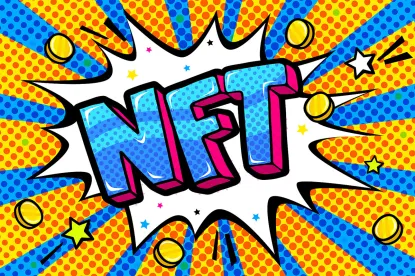On March 21, 2023, the Department of the Treasury and the Internal Revenue Service (“IRS)” released Notice 2023-27, announcing their intent to provide guidance on classifying certain non-fungible tokens (“NFTs”) as “collectibles,” which could subject owners of NFTs to higher long-term capital gains tax.
Digital assets, such as NFTs and cryptocurrencies, are currently generally classified as “property.” Therefore, under current law, gains from the sale or exchange of NFTs are taxed based on how long such NFT was held by the owner. For instance, if the owner sells an NFT he or she has held onto for one year or less, then the sale of such NFT would be subject to short-term capital gains tax. Short-term capital gains are taxed at the ordinary income rates, and the federal[1] ordinary income tax rates currently range from 10 percent to 37 percent depending on the taxpayer’s taxable income. On the other hand, if the owner sells an NFT he or she has held on to for more than one year, the sale of such NFT would be subject to federal long-term capital gains tax. Long-term capital gains are subject to federal tax at a rate of zero percent, 15 percent, or 20 percent depending on the taxpayer’s taxable income.
Notice 2023-27 is the first notice where the IRS has announced its intent to differentiate NFTs from other digital assets. Notice 2023-27 defines an NFT as “a unique digital identifier that is recorded using distributed ledger technology and may be used to certify authenticity and ownership of an associated right or asset.” The IRS further defines NFT’s “associated right or asset” as the holder’s right to a “digital file” (i.e., image, music, trading card, or sports moment) or a right with respect to an asset that is not a digital file (i.e., right to attend a ticketed event or certify ownership of a physical item).
The IRS has requested written comments from the public, on or before June 19, 2023, on its intention to classify NFTs as collectibles under Section 408(m)(2) of the Internal Revenue Code of 1986, as amended (the “Code”), and further guidance on how the IRS should determine whether an NFT is a collectible or property.
Section 408 of the Code applies to individual retirement accounts (“IRAs”), and therefore, Notice 2023-27 specifically addresses the tax treatment of transactions where NFTs are acquired by IRAs. Nevertheless, the classification of an asset as a collectible under Section 408 of the Code may also result in the classification of such asset as a collectible for the purposes of an ordinary sale or exchange. Section 408(m)(2) of the Code defines a “collectible” as: “(A) any work of art, (B) any rug or antique, (C) any metal or gem, (D) any stamp or coin, (E) any alcoholic beverage or (F) any other tangible personal property specified by the Secretary for purposes of this subsection.” Similar to property, the sale or exchange of a collectible held by an owner for one year or less would be subject to short-term capital gains tax at the same rates indicated above. However, the sale or exchange of a collectible held by an owner for more than one year would be subject to long-term capital gains at a rate as high as 28 percent, depending on the taxpayer’s taxable income, which is eight percent higher than the maximum long-term capital gains tax rate on the sale or exchange of property.
According to Notice 2023-27, the IRS is proposing the application of a “look through analysis” to determine whether a specific type of NFT should be classified as a collectible or property. Under such analysis, an NFT will be classified as a collectible if its “associated right or asset” (as defined above) is considered a collectible under Section 408(m)(2) of the Code. For instance, a stamp is considered a collectible under Section 408(m)(2)(D) of the Code. Under the look-through analysis, if an NFT certifies the ownership of a stamp, such NFT would be classified as a collectible. On the other hand, if an NFT provides a right to use or develop a “plot of land” in the metaverse, such NFT would not be classified as a collectible. Therefore, buying a plot of land to be Snoop Dogg’s or any other celebrity’s neighbor in the metaverse will not be considered a collectible.
While some of the items listed as collectibles under the Code are clear, the IRS is specifically requesting further guidance on the extent to which a digital file may constitute a “work of art” under Section 408(m)(2)(A). This may raise a multitude of concerns for NFT owners, especially if such definition is applied broadly to images. This further raises the issue of how “multipurpose” NFTs, such as Bored Ape Yacht Club, would be classified under the look-through analysis. Bored Ape Yacht Club is a collection of 10,000 unique images that have gained popularity among NFT owners. In fact, Sotheby’s Metaverse market sold one Bored Ape NFT for approximately $3,400,000 in October 2021. The Bored Ape NFTs are used as profile pictures and status symbols, and also provide owners of Bored Ape NFTs with special perks such as exclusive online member-only areas, limited edition merchandise, and exclusive entrance to real-world events for Bored Ape NFT owners.
As the June 19, 2023, deadline is quickly approaching, taxpayers with significant NFT investments should strongly consider taking advantage of the opportunity to submit comments to the IRS regarding whether NFTs should be classified as collectibles and, if so, the appropriate test to determine whether a specific NFT is a collectable or ordinary property.
[1] Depending on the taxpayer’s state tax residency, the taxpayer may also be subject to state-level income taxes.



 />i
/>i


